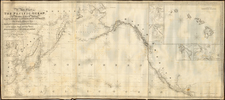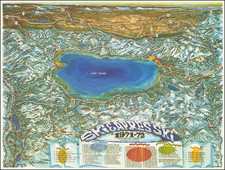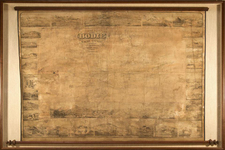Mapping Orange County Infrastructure Before The Residential Construction Boom
Joined set of Orange County Quadrangle maps, which have been hand annotated to show infrastructure around Huntington Beach and the surrounding communities.
The present map shows a series of hand drawn and numbered green lines. These would appear to be related to the planning of the water and sewer system for Huntington Beach in the early 1950s, when it was being converted from a booming oil producing region to the fastest growing city in the US in the 1950s.
In the Huntington Beach area, numerous oil wells and several oil pipelines are noted. Perhaps the most interesting feature of the map are the numerous small communities shown, many of which have been completely swallowed up by the path of development in the past 75 years. These include:
- Colonia Juarez
- Midway City
- Silver Acres
- Boulevard Gardens
- Wintersburg
- Ocean View
- Talbert
A number of no longer operating airports and landing fields are noted, presaging Orange County's evolution from oil and agriculture to aerospace, technology and residential sprawl.
Huntington Beach
Huntington Beach was home to the Tongva people, also known as the Gabrielinos, whose territory spanned from Topanga Canyon to Aliso Creek in Laguna Beach.
The European chapter of Huntington Beach's history began in 1784 with Spanish soldier, Manuel Nieto. Awarded a sprawling 300,000-acre Spanish land grant, he named it Rancho Los Nietos. By the early 1800s, portions of this vast property were sold to Col. Robert Northam, who cultivated and sold barley to neighboring ranchers. As the 19th century drew to a close, the area, named Shell Beach by 1889, witnessed an influx of settlers.
In 1901, Shell Beach was rechristened Pacific City following P.A. Stanton's vision of creating a coastal town to rival Atlantic City. By 1909, the city incorporated as Huntington Beach, named after Henry Huntington, a railroad tycoon. The Huntington Beach Company, owned by Henry Huntington, played a pivotal role in the city's initial development and continues to be a prominent landowner.
The 1920s saw Huntington Beach transformed by an oil boom, which marked the city's most significant growth spurt. In a span of weeks, the population leaped from 1,500 to 5,000. This boom lasted until a final oil strike in 1953, after which the city began a phase of rapid urbanization, making room for a population explosion in the 1950s. By the late 1950s, Huntington Beach was the fastest-growing city in the continental U.S., with a continuous wave of housing developments.
As the 20th century progressed, the city adapted and evolved. The 1970s and 1980s saw a cosmetic overhaul as oil rigs were discreetly concealed to bolster the beach's appeal. Concurrently, the aviation industry left its mark. Donald Douglas Jr. initiated the Douglas Aircraft Space Systems Center, which eventually became a significant part of Boeing.













![(Oil Wells - Santa Fe Springs, Los Angeles County, California) Sante Fee Springs [sic]](https://storage.googleapis.com/raremaps/img/small/95397.jpg)


